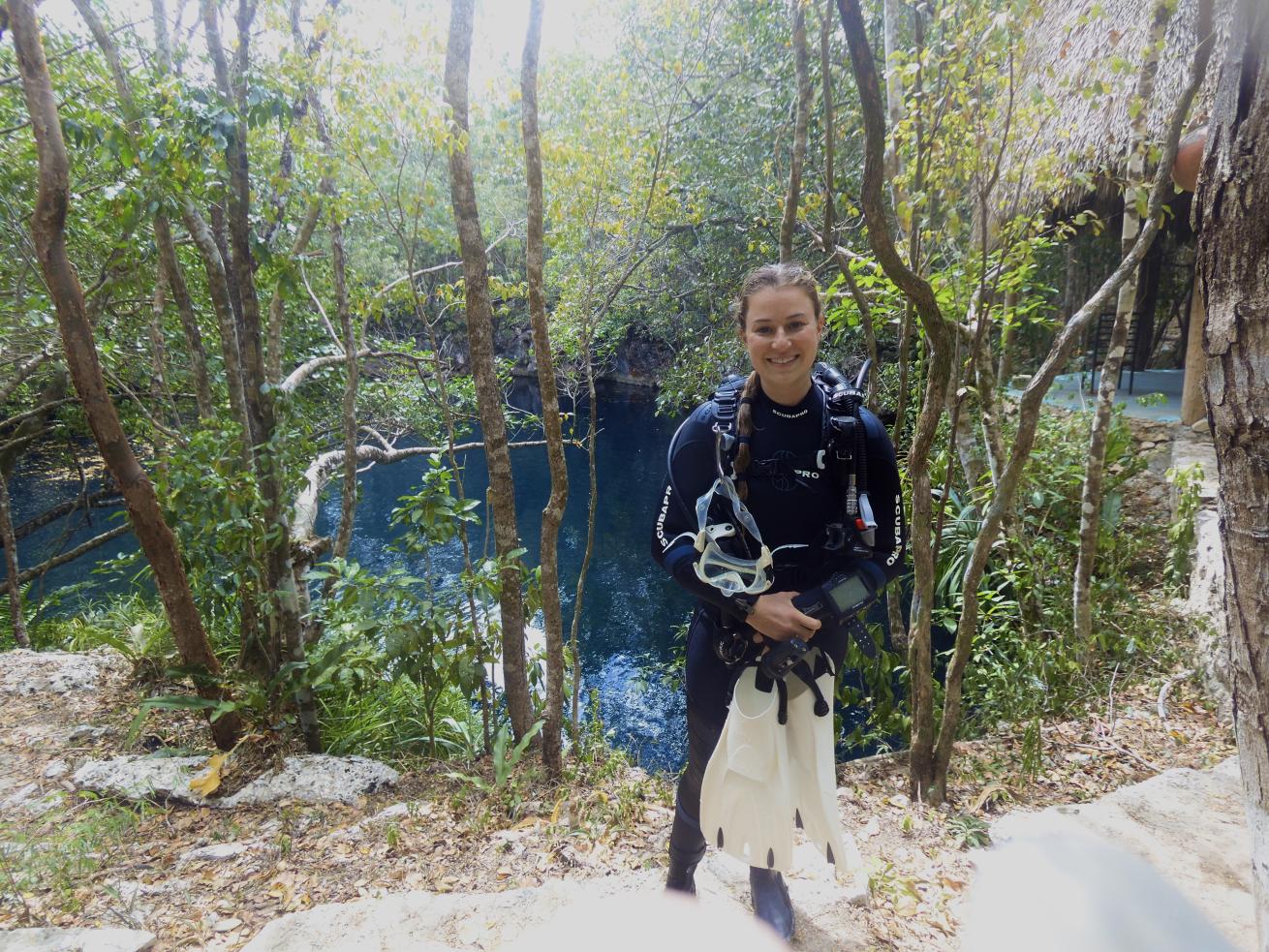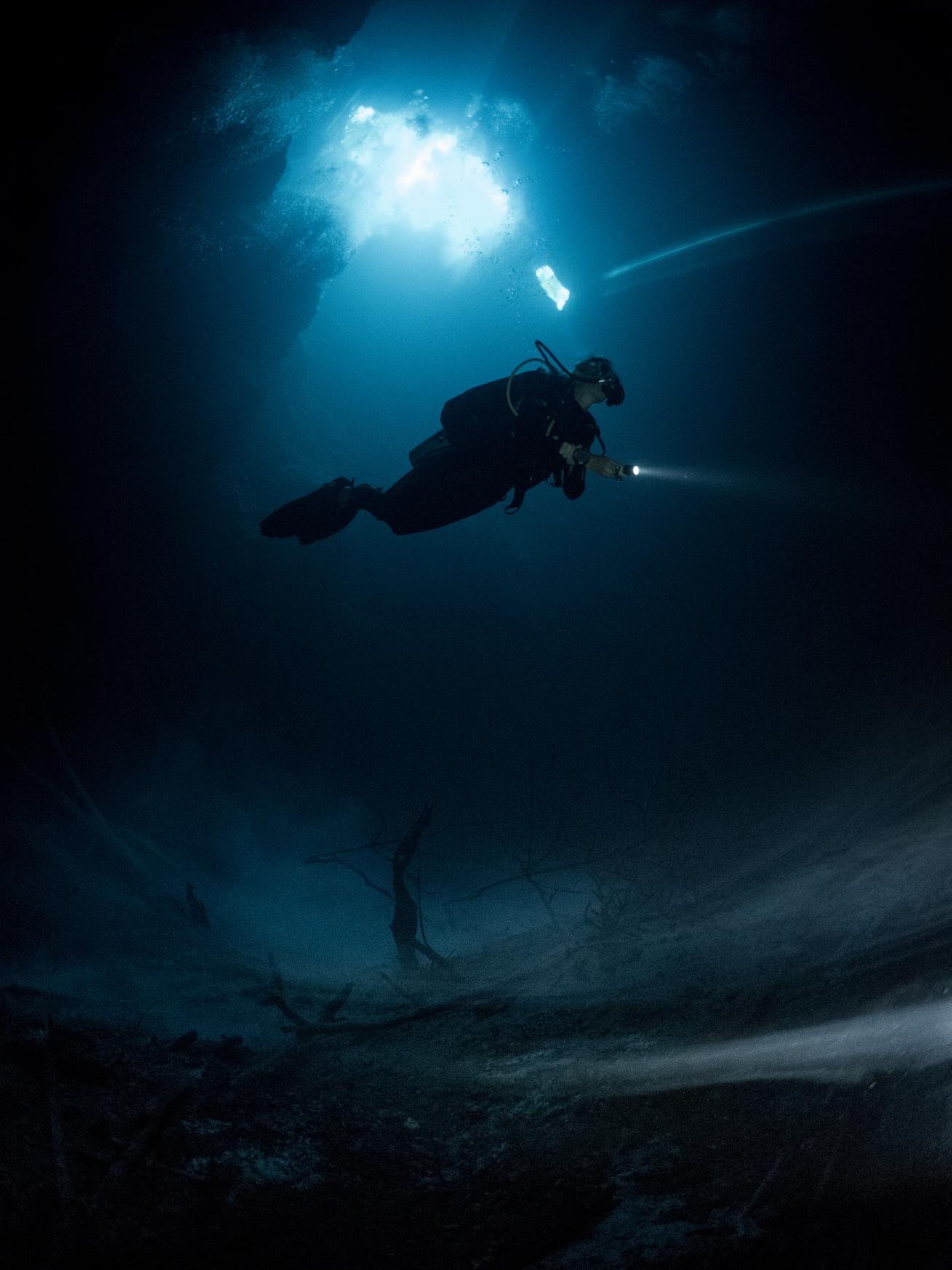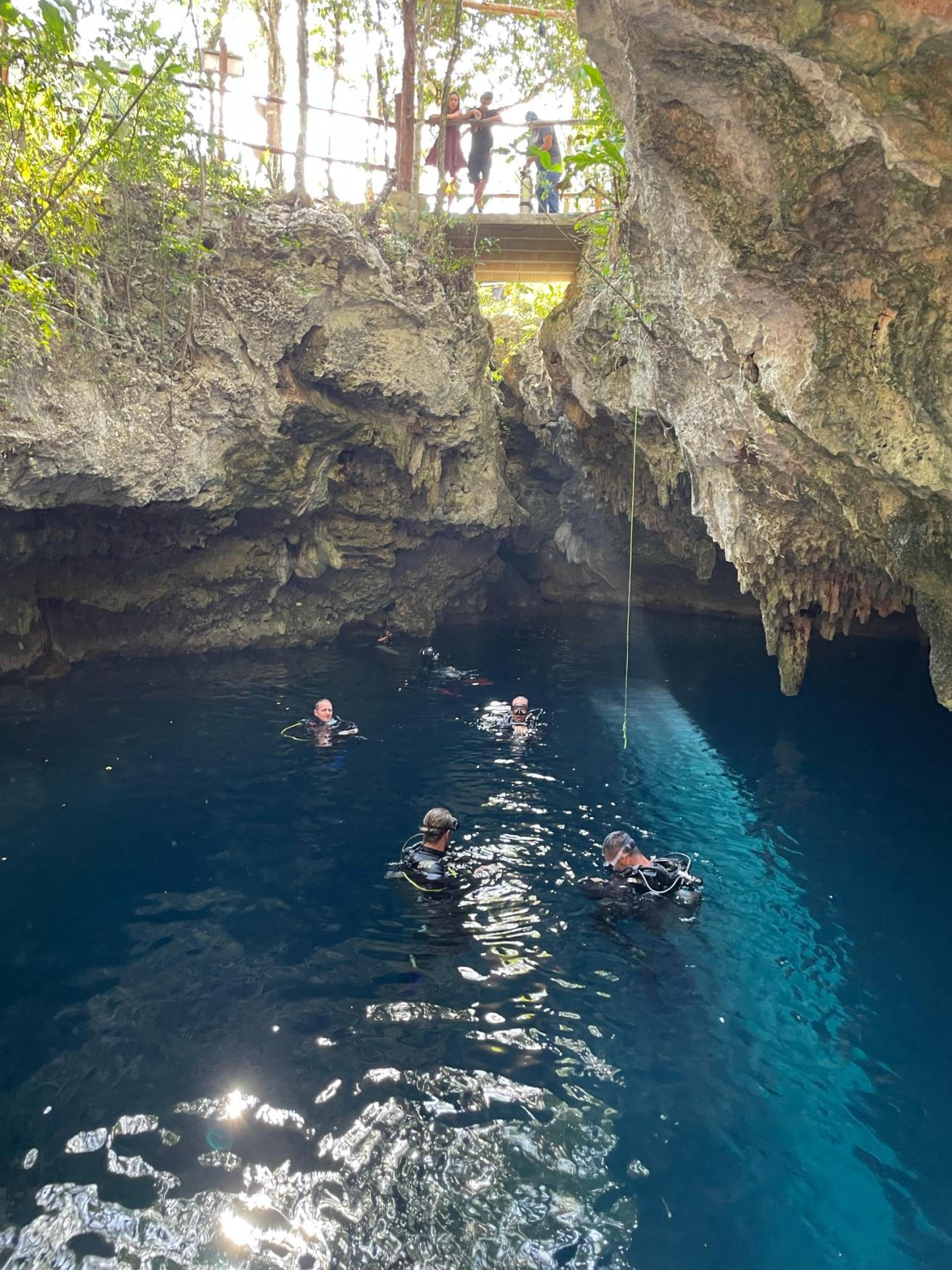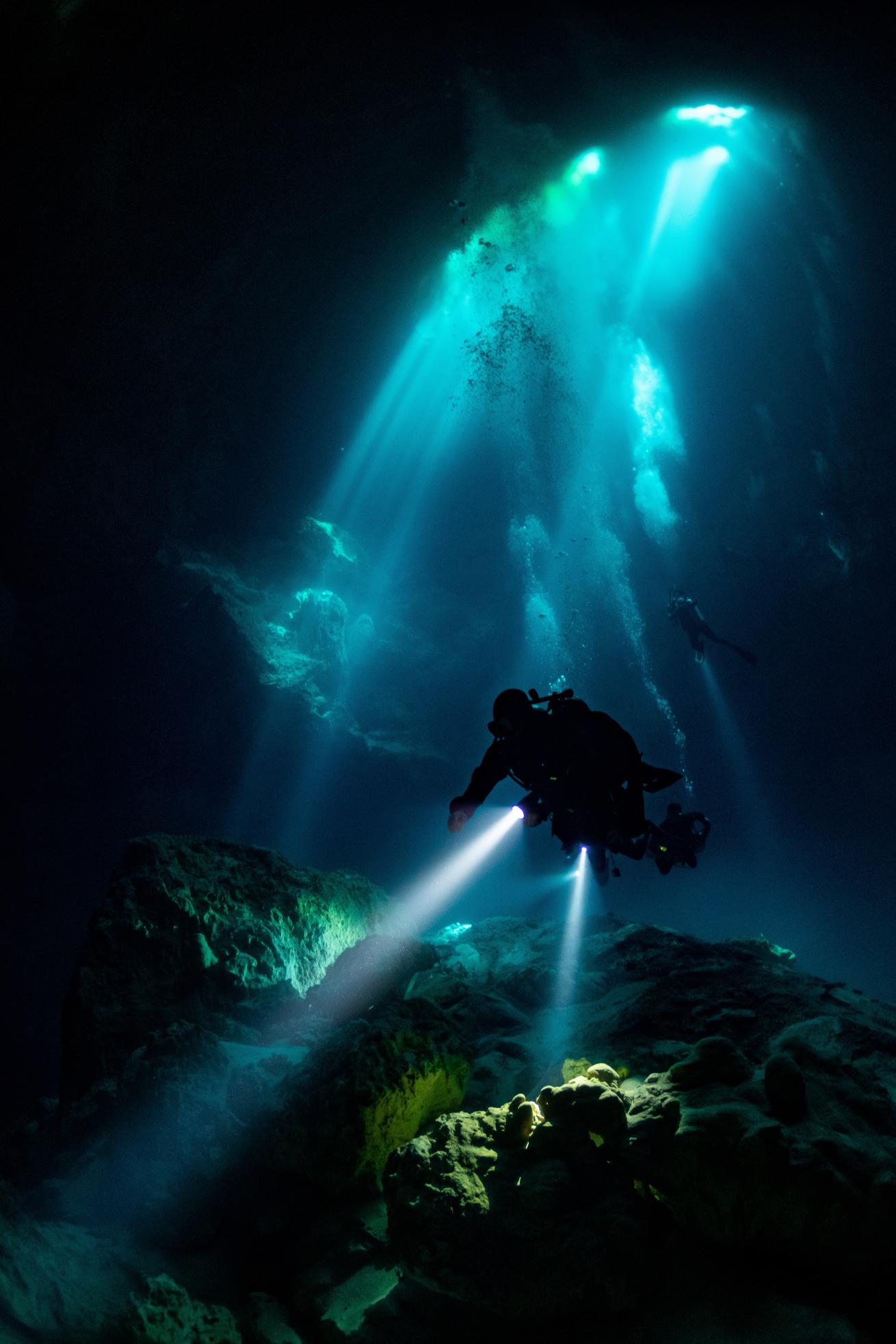Discovering the Wonders of Mexico's Cenotes for the First Time

Ariella SimkeAuthor Ariella standing in front of the entrance to cenote “Angelita” after an awe-inspiring dive.
I was braiding my sister’s hair in front of the 7/11 in Tulum when our ride arrived. Our guide, Paco, from the tour company The Cenote Guy, loaded our dive gear into the bed of the truck and we were off. Rumbling through the jungle, we headed toward Parque Dos Ojos, where our first-ever cavern, locally known as cenotes, dives would take place.
A Diver’s Playground
Cenotes in Mexico’s Riviera Maya are thrilling playgrounds for scuba divers and freedivers. These natural pools are created when cave ceilings collapse, revealing crystal-clear water and impressive stalactites and stalagmites that have taken thousands of years to form. The geology of the area is captivating, enchanting us into the underground maze.
Millions of years ago, the entire Yucatan Peninsula was a coral reef ecosystem. Falling sea levels exposed the limestone foundation secreted by reef-forming organisms, which became the bedrock of the region and the backbone of the cenotes. As part of the dissolution process, rainwater dissolved the limestone bedrock over time, creating vast cave systems. When sea levels rose again after the last ice age, intruding salt water from the Caribbean Sea seeped into the cenotes, and rainwater continued to fill them up. These filled structures are what divers explore today.

Shutterstock.com/[JimCatlinPhotography](https://www.shutterstock.com/g/JimCatlinPhotography)A diver explores a cenote in Mexico's Riviera Maya.
Descending Into The Pit
We arrived at our first site, “The Pit,” part of the longest known underwater cave system called Sac Actun, which runs about 226 miles, and received a thorough briefing. My sister and I listened intently as our guide talked us through the geology of cenotes, our detailed dive plan, the importance of trim and buoyancy in the tight quarters we were about to experience, and the rule of thirds—a cave diving approach to air consumption in which you use one-third of your air going in, one-third coming out, and one-third is kept as a reserve. Each guide must have specific training and certification as a full cave diver and be an official Cenote Guide. Guides are only allowed to bring four certified divers in at a time, and must not go beyond the cavern zone (daylight must remain visible.) The locals are serious about protecting these very delicate and old ecosystems. That means absolutely no touching, and no sunscreen or cosmetics can be worn in the water.
We followed Paco past the other divers gearing up in the jungle parking lot and down the steep wooden stairs to a platform beneath the earth. Paco showed us fossilized shells embedded in the cavern's walls and instructed us to giant stride into the flat water below. On the surface, bursts of rising bubbles echoed inside the limestone room in gurgling blasts.
I put my mask to my face and looked below me. Through the dark, glasslike water I could clearly make out over a dozen other divers circling through the cavern with bright lights. The cavern itself was quite dark, the only light coming from the gaping entrance above me, but this is actually one of the brighter cenotes in the area. I looked back up in time to catch a view of someone lowering their sidemount tanks with a rope and winch through the opening of the cenote and down to the water, about 20 feet below, giving new meaning to “work smarter, not harder.”

Ariella SimkeSidemount divers lower tanks into the cenote via a rope, while divers in the water prepare to descend into The Pit.
A Thrilling Experience
We took a few breaths to ready ourselves, released the air in our BCDs, and then we were flying through water. The Pit has different layers—the first is fresh water. We descended past it as shafts of sunlight crept through the entrance into the belly of the cavern. Next, we sunk into the thick halocline layer, where salt and freshwater meet. This mingling of less-dense fresh water and denser salt water that seeps in from below creates a swirling optical illusion where your vision goes blurry for several seconds until, lowering still, you emerge into the clear salt water on the other side. I looked at my sister and we threw up ecstatic shakas to signal our amazement.

Shutterstock.com/subphotoIt takes special training and equipment to enter into the cave system.
After exploring the walls and looking into small caves inside the cavern, we reached the deepest point of our dive at about 110 feet. Paco led us toward the famous hydrogen sulfide cloud, or “the cloud” as he called it. A layer of toxic, putrid-smelling gas emitted from the decaying organic matter that periodically falls into the opening of the cenote. As soon as we swam into it, I was shocked to smell the rotten-egg stench through my mask. “Don’t clear your mask inside the cloud,” Paco had warned us. The gas can kill you at high enough concentrations. Once inside, the visibility dropped to zero. A wispy white curtain fell before my mask, and I felt like I was flying through a blizzard. We emerged and finned above the cloud back into clarity. Looking down, I could see the petrified limbs sprouting from long-dead trees poking out of the fog. We headed toward the opening, stopping to admire the long stalactites that looked as if they were dripping from the ceiling.
On the surface, we climbed out in awe. Paco’s excitement had clearly not waned in his many years of diving these sites, and I could already tell mine never would, either. I did three more cenote dives at the renowned Angelita, Dreamgate and Dos Ojos sites before I ran out of time in Tulum. On each one, I mourned the moment Paco thumbed the dive, signaling it was time to surface. As soon as I got home, I began researching my impending cave courses in earnest. I was hooked.
NEED TO KNOW:
Temperature: 76 degrees F year round
Gear: 5mm wetsuit, two lights
Recommended certifications: Advanced Open Water, Peak Performance Buoyancy, Nitrox, Cavern Diver
Remember: Never enter a cave or other overhead environment without first getting the proper training and specialized equipment for that environment.










